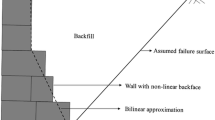Abstract
Knowledge of seismic active earth pressure behind rigid retaining wall is very important. In this paper, the pseudo-dynamic approach, which considers the effect of both compression and shear wave propagation, is adopted to calculate the seismic active force supporting c-Φ backfill. Considering a planar rupture surface, the effect of wide range of parameters like inclination of retaining wall, wall friction and soil friction angle, shear wave and compression wave velocity, horizontal and vertical seismic coefficients are taken into account to evaluate the seismic active force. Results are presented in terms of seismic coefficients in tabular form and variation of pressure with depth.









Similar content being viewed by others

Abbreviations
- ϕ, δ:
-
Angle of internal friction of soil and angle of wall friction, respectively
- k h , k v , k h g, k v g:
-
Horizontal, vertical seismic coefficients, horizontal and vertical seismic accelerations, respectively
- g :
-
Acceleration due to gravity
- K sγ , K sc :
-
Static active earth pressure coefficient due to unit weight and cohesion, respectively
- q, Q:
-
Unit surcharge and total surcharge acting on the top of the backfill, respectively
- γ, W:
-
Unit weight and total weight of the backfill, respectively
- V s , V p :
-
Shear wave and primary wave velocity within the backfill, respectively
- θ :
-
Inclination of the backfill wedge surface with vertical
- c, c a :
-
Unit cohesion and unit adhesion, respectively
- ρ, μ, G:
-
Density, Poisson’s ratio and Shear modulus of soil medium, respectively
- T, ω:
-
Time period and angular frequency of the vibration generated due to earthquake
- t :
-
Any time up to a time period T
- H, H0:
-
Total Height of the retaining wall and height of the cracked zone of the backfill
- H 1 :
-
H–H0
- λ,η:
-
Wave length of the shear wave and primary wave, respectively
- Q h (t), Q v (t):
-
Horizontal and vertical seismic inertia forces, respectively
- P sγ , P sq and P sc :
-
Static component of active earth force due to unit weight, surcharge and cohesion, respectively
- P dγ , P dq :
-
Dynamic increment due to earthquake for unit weight and surcharge, respectively
- P ae :
-
Total seismic earth force acting on the back of retaining wall
References
Choudhury D, Nimbalkar S (2005) Seismic passive resistance by pseudo-dynamic method. Geotechnique 55(9):699–702
Choudhury D, Nimbalkar S (2006) Pseudo-dynamic approach of seismic active earth pressure behind retaining wall. J Geotech Geol Eng 24:110–1113
Choudhury D, Singh S (2006) New approach for estimation of static and seismic active earth pressure. Geotech Geol Eng 24:117–127
Coulomb CA (1773) Essai sur une application des regles des maximis et minimis a quelque problems de statique relatifs 1’ architecture. Memoires d’Academie Roy Pres Diverssavants 7
Das BM (1993) Principles of soil dynamics. PWS, KENT Publishing Company, Boston
Fukuoka M, Imamura Y (1984) Researches on retaining wall during earthquakes. In: Proceedings, eighth world conference on earthquake engineering, San Francisco, USA, vol 3. pp 501–508
Ghosh P (2007) Seismic passive earth pressure behind non-vertical retaining wall using pseudo-dynamic analysis. J Geotech Geol Eng 25:693–703
Ghosh S (2010) Seismic active earth pressure coefficients on battered retaining wall supporting inclined c-Φ backfill. Indian Geotech J, accepted for publication
Ghosh S, Dey GN, Datta B (2008) Pseudo-static analysis of rigid retaining wall for dynamic active earth pressure. In: 12th International Conference of International Association for Computer Methods and Advances in Geomechanics, Goa, India, 2008. pp 4122–4131
Mononobe N, Matsuo H (1929) On the determination of earth pressure during earthquakes. In: Proceedings, world engineering conference, vol 9. p 176
Okabe S (1926) General theory of earth pressure. J Jpn Soc Civil Eng Tokyo Japan 12(1)
Richards R, Elms DG, Budhu M (1990) Dynamic fluidization of soils. J Geotech Eng ASCE 116(5):740–759
Saran S, Gupta RP (2003) Seismic earth pressure behind retaining walls. Ind Geotech 33(3):195–213
Shukla SK, Gupta SK, Sivakugan N (2009) Active earth pressure on retaining wall for c-Φ soil backfill under seismic loading condition. J Geotech Geoenviron Eng 135(5)
Steedman RS, Zeng X (1990) The influence of phase on the calculation of pseudo-static earth pressure on a retaining wall. Geotechnique 40(1):103–112
Zeng X, Steedman RS (1993) On the behavior of quay walls in earthquakes. Geotechnique 43(3):417–431
Author information
Authors and Affiliations
Corresponding author
Rights and permissions
About this article
Cite this article
Ghosh, S., Sharma, R.P. Pseudo-Dynamic Active Response of Non-Vertical Retaining Wall Supporting c-Φ Backfill. Geotech Geol Eng 28, 633–641 (2010). https://doi.org/10.1007/s10706-010-9321-9
Received:
Accepted:
Published:
Issue Date:
DOI: https://doi.org/10.1007/s10706-010-9321-9



